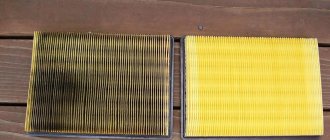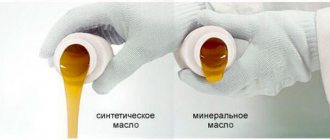Types of oils
Box oil, like motor oil, comes in 3 main types: synthetic, semi-synthetic and mineral. It should be noted that when choosing a liquid, this is not the main selection criterion. The main attention should be paid to the viscosity of the oil with its relation to operating temperatures.
Synthetic transmission fluids have greater fluidity, which, unlike mineral oil, does not depend on temperature. The same can be said about viscosity. Synthetics practically do not change their viscosity characteristics when the temperature changes, unlike mineral ones. Also, synthetic fluids are less susceptible to aging and oxidation.
Mineral oil creates an elastic oil film on surfaces that protects against wear and contamination. But it is more sensitive to temperature changes. At low temperatures, the fluid thickens, which puts additional load on the engine, which has to rotate the gearbox gears or driveshaft gearbox. As the oil warms up, these problems disappear.
However, if you choose the right oil based on the operating temperatures of the unit and the conditions in which it operates, both synthetic and mineral water will work equally well.
There is also an alternative - semi-synthetic gear oil. It combines the features of mineral water and synthetics, both positive and negative. Such fluids are universal and have good anti-friction and protective properties.
Transmission oils - classification according to GOST
We inherited the GOST classification from the Soviet era, but not everything was so bad there. The systematization was based on document number 17479.2-85, which divided all transmission oils into 4 main classes - 9, 12, 18 and 34, according to the main characteristic typical of all oils in general - viscosity. Viscosity was determined experimentally, under loads at extreme temperatures of 100 and 150 degrees (kinematic and dynamic viscosity). Further, transmission oils were divided based on their direct operational properties, which gave rise to 5 main groups for use.
- The first group is mineral oil without additives, indicated for use in gears: worm, cylindrical, canonical with a maximum contact load from 900 to 1500 MPa at a temperature of 90 degrees Celsius.
- The second group - mineral oil containing an anti-wear additive, is indicated for use in gears: worm, cylindrical, canonical with a maximum contact load of up to 2100 MPa at temperatures up to 130 degrees Celsius.
- The third group is a mineral oil containing an extreme pressure additive with a moderate impact, indicated for use in gears: helical-canonical, cylindrical, canonical and hypoid with a maximum contact load of up to 2500 MPa at temperatures up to 150 degrees Celsius.
- The fourth group is a mineral oil containing an extreme pressure additive with a high impact, indicated for use in gears: helical-canonical and hypoid with a maximum contact load of up to 3000 MPa at the same temperature maximum.
- The fifth group is universal oils and mineral oils containing a multifunctional extreme pressure additive with high impact, indicated for use only in hypoid gears (with shock loads) with a maximum contact load of up to 3000 MPa under the same temperature conditions.
Accordingly, the domestic marking of transmission oil looks something like this - TM-5-9(3), where TM is a designation that the oil is transmission, "5" - a multifunctional high-impact extreme pressure additive is present, "9" - low-viscosity oil, "(3 )" - contains a thickening additive for year-round use.
Marking
Transmission oils, like motor oils, are marked SAE, which indicates the viscosity of the oil. Let's look at the example of SAE 75W-90 gear oil (semi-synthetic and synthetic gear oils). The number 75 means the degree of fluidity at low temperatures. The number 90 is the viscosity index, which is demonstrated by the oil at a temperature of +100 °C.
If there is no number after W, this means that the oil is intended for winter use only. If the letter W is absent altogether, then such a liquid is only suitable for use in the summer.
According to the climatic conditions of Russia, oils can be divided according to geographical purpose:
- For southern regions, fluids with a viscosity of SAE 140 and higher are ideal.
- For temperate climates - liquids with an SAE viscosity of about 90
- For cold climates - 75W-90
According to the API system, transmission fluids have an applicability and quality index, which is designated from GL-1 to GL-6. The larger the number after the letters, the higher the quality of the oil and the guarantee of its reliability. For example, GL-5 oils are high quality oils.
- GL-1 – additive-free fluids intended for manual transmissions without synchronizers in trucks
- GL-2 – fluids with anti-wear additives intended for equipment that operates under medium and heavy loads
- GL-3 – fluids with anti-wear additives (up to 2.7%), recommended for transmissions of trucks that operate under medium and heavy loads
- GL-4 – universal fluids with anti-wear additives (up to 4%), which are used in synchronized and non-synchronized gearboxes of passenger cars, trucks and buses
- GL-5 - this type of fluid is intended for gearboxes of vehicles that operate under very difficult conditions. Contains up to 6.5% multifunctional additives (extreme pressure, anti-foam, etc.)
- GL-6 – fluids for hypoid gears, which contain up to 8.5% anti-wear additives and are used in gearboxes of cars with powerful engines.
Passenger cars are traditionally filled with the 2 most common types of oils: GL-4 and GL-5. In Russian labeling these are TM-4 and TM-5 oils. There is also a universal class of fluids GL-4/5, which is suitable for different types of gears.
GL-4 oils are intended for use in bevel gear and hypoid gearboxes, assemblies and elements of the drive axle, where maximum loads do not exceed normal ones.
GL-5 is used in hypoid high speed transmissions that operate under high loads and temperatures.
GL-5 oils are divided into the following types based on viscosity:
- 75W-90 - synthetic or semi-synthetic fluids of medium viscosity
- 80W-90 - thick mineral oils, for example Mobil Mobilube HD
- 85W-90 - thicker mineral oils, for example Lukoil TM-5-18
Classification of gear oils by viscosity grade (SAE)
The ability of transmission oils to lubricate rubbing parts and create a protective film on their surface is determined by such a physical parameter as viscosity.
This term refers to the property of fluid substances to resist the movement of their layers relative to each other. There are dynamic viscosity (characterizes the force of internal friction of the transmission oil) and kinematic, which is the ratio of dynamic viscosity to the density of the substance (in fact, it determines its fluidity). A classification of lubricants based on viscosity properties and the nature of their changes depending on temperature was developed by the Society of Automotive Engineers (SAE, Society of Automotive Engineers). In accordance with it, it is customary to distinguish three broad categories of transmission oils:
- winter,
- summer,
- all-season.
Let's consider each of them separately.
Winter oils include transmission oils whose dynamic viscosity at a calculated negative temperature does not exceed 150,000 mPa s.
In other words, this category includes oils that, even in severe frost, retain their lubricating properties at a level sufficient to prevent mechanical damage to the transmission during a cold start.
They are marked like: SAE 70W
Here the digital index indicates the viscosity-temperature properties of the oil, and the letter W
(from the English Winter - “winter”) indicates that it is suitable for use in the cold season.
| SAE class | Minimum temperature at which dynamic viscosity is 150,000 mPa s (°C) | Minimum kinematic viscosity at t = 100 °C (mm2/s) |
| 70W | −55 | 4,1 |
| 75W | −40 | 4,1 |
| 80W | −26 | 7,0 |
| 85W | −12 | 11,0 |
Summer oils
received the following marking: SAE 80
Here the digital index correlates with the minimum and maximum kinematic viscosity of the transmission oil when it is heated to 100°C. The fact is that high temperatures increase the fluidity of oils
, as a result, their lubricating characteristics also decrease, since the film designed to protect the metal from friction turns out to be too thin. As a result, the ability of an oil to maintain a constant consistency at high temperatures turns out to be no less important than the ability to resist thickening in winter.
| SAE class | Kinematic viscosity at t = 100 °C (mm2/s) | |
| Min. | Max. | |
| 80 | 7,0 | 11,0 |
| 85 | 11,0 | 13,5 |
| 90 | 13,5 | 18,35 |
| 110 | 18,5 | 24,0 |
| 140 | 24,0 | 32,5 |
| 190 | 32,5 | 41,0 |
| 250 | 41,0 | — |
All-season gear oils
are double marked. As an example, let's decipher the SAE 75W-80 indicator using the tables above.
This gear oil is suitable for operation at temperatures down to −40°C (index 75W) and is characterized by a kinematic viscosity from 7.0 to 11.0 mm2/s at 100°C (index 80).
Most all-season oils can be used at ambient temperatures up to +35°C, however, there are also brands for hot climates that maintain constant viscosity-temperature properties even at +45°C (these include SAE 85W-90).
Additives
Modern gear oils contain various additives. The most common are sulfur-phosphorus additives, which create a special protective coating that protects against wear. In terms of density, such a layer is superior to copper and other parts made of soft materials. In the future, this leads to wear of both the protective layer and the soft metal parts of the box.
The characteristics of transmission oils are such that some fluids are not suitable for synchronized gearboxes. The use of such materials will only increase the wear of copper synchronizers and other elements.
Rating of transmission oils
To compile this rating, we analyzed many offers on the market, choosing from them the most worthy according to driver reviews. Before including a specific product in the TOP, the opinions of customers were carefully studied. Many factors were taken into account:
- Company manufacturer;
- Price;
- Oil type – mineral, synthetic or semi-synthetic (mixed);
- Viscosity grade;
- Anti-friction properties;
- Quality of lubrication of parts;
- Efficiency of preventing wear of working elements;
- Purpose - for which gearbox it was produced;
- Environmental friendliness of the composition;
- Are there any leaks?
- Reliable prevention of deposits and corrosion;
- Number of tolerances;
- Compliance with international quality standards;
- Volume;
- Savings in consumption.
The best antifreezes
Possibility of replacing one oil with another
As mentioned above, GL-4 gearbox oil works with units that operate at moderate loads and speeds, and GL-5 – with high loads.
But the fundamental difference lies in the additives. In GL-5 fluids they have very high extreme pressure properties and, therefore, are not combined with synchronizers in the gearbox. The use of such oils causes an unpleasant grinding noise and will completely disable the mechanism in the future.
If the oil is changed at a service station, in addition to the gearbox, the oil in the drive axles can also be updated. If GL-4 fluid is poured into it, the seals may leak and noise will appear. This happens because the small volume of the container into which the pump supplies liquid forces it to either flow out through the seal or affect the bearing. Therefore, it should be remembered that GL-4 is intended exclusively for the gearbox, and GL-5 is intended for components and assemblies that are located in the drive axles.
As a result of the analysis of various transmission fluids and methods of their use, the following conclusions were drawn:
- The most optimal all-season fluid is SAE 75W-90. It works equally well in any climate zone
- SAE 80W-90 hypoid gear oil has good performance and works well in both summer and winter.
- When choosing a liquid, its type is not at all important - mineral water, semi-synthetic, synthetic. The properties of each specific material, its purpose, viscosity index, presence and properties of contained additives are much important.
Is it possible to do this?
If you take liquids for your car that have the same classification according to API, without additional approvals and manufacturer’s notes, on the same basis, then there will be no harm from mixing. Since their compatibility and interchangeability is guaranteed by this standard. For example, when mixing two gl5 oils, you get a substance that has the same properties, and therefore is suitable for the same operating conditions and units.
It is permissible to mix lubricants of different brands, if the properties are not lost or changed; this applies to oils produced by one factory, only with different stickers. Then they are chemically equivalent, they can be mixed and one substance can be replaced with another. However, sellers of ordinary stores (not company-owned or branded), as a rule, do not have such information. Therefore, when purchasing goods in these stores, you are playing a kind of lottery. I wouldn't recommend this.
You cannot mix automatic transmission oil with mechanical lubricant, compositions of completely different viscosities, the mixture will be equally destructive for both boxes.
Difference in oil by box type
In addition to differences in viscosity and purpose, the oil in the box is divided into materials for manual and automatic transmissions.
For manual transmission
This oil, mainly mineral and semi-synthetic, removes rust particles and heat well, lubricates friction pairs and effectively relieves mechanical stress.
It should be remembered that all gears and the bearings located within them require lubrication by immersion in oil and splashing. Complex and/or heavily loaded mechanisms require more lubrication. In this case, the oil is forced to flow to the components under a certain pressure.
For automatic transmission
Automatic transmission oils meet higher requirements than mechanical materials. They serve to transfer mechanical energy throughout the transmission, so they are somewhat similar to hydraulic fluids. For example, synthetic gear oil for automatic transmissions is better resistant to foaming and has a higher viscosity index, and also has high oxidation resistance.
Such materials not only lubricate gears, but also better dissipate heat, protect against corrosion, ensure smooth operation of clutches and provide a fluid environment.
Also, oils for automatic transmissions are compatible with many elastomers, unlike materials for manual transmissions.
Quite often you can hear the question: “Can automatic transmission oils be used in a manual transmission?” In principle, manual automatic fluid works even better, but replacement of this kind will cost owners more.
Which brand of transmission oils is better to choose?
The oil market, including transmission oils, is very saturated with various offers. Among them there are both budget and mid-priced brands, as well as premium brands. This rating included products from both foreign manufacturers and domestic and Russian companies. Here are the companies we are talking about:
- Shell is a British-Dutch oil and gas company that supplies gasoline, lubricants, motor and transmission oils to the international market. She has both completely synthetic and mineral products. There are optimal offers for both low-power and serious engines. The company produces products for cars, trucks, and motorcycles. It is environmentally friendly, safe and has an optimal price-quality ratio.
- Eneos is a Japanese company that produces oils and transmission fluids with a wide selection of viscosity, density, and operating temperature conditions. Its products are suitable for use in any season, even in harsh winters. There are options for both automatic and manual transmissions. They are sold in several volumes - 0.94 l, 1.88 l, 20 l and 200 l, and usually, if you buy a large quantity at once, you can save a lot of money.
- ZIC is a huge industrial concern engaged in the extraction and refining of oil, which is supplied to many countries around the world. Its product range includes fuel, automotive lubricants, and transmission oils. Basically, here we are talking about completely synthetic products that have excellent astringent, anti-friction, and anti-corrosion properties. They have reasonable prices and good quality.
- Luxe - transmission oils of this brand are created using the latest technologies, which guarantees long transmission life, smooth gear shifting, prevention of wear of parts and elimination of friction. There are offers here for both manual and automatic transmissions. Most often, they can be used in all weather conditions, even in extremely cold winters. The company has provided options for passenger cars, trucks and other equipment.
- Rosneft is a Russian oil and gas company, one of the largest oil producers in the world. It produces transmission oils for cars, trucks and other equipment. Depending on the type, they can be used in both automatic and manual transmissions. Their use ensures efficient operation in difficult conditions. The company's product range includes synthetic and semi-synthetic lubricants.
- Castrol is a European brand under which products are manufactured in Germany, Austria, Italy and Belgium. It is created on the basis of innovative developments and is recommended for use by such car market giants as Opel, Porsche, Ford, Chevrolet and others. They are stable in operation, regardless of temperature and season. With their help, premature wear and overheating of parts is eliminated. They also help protect them from corrosion and thereby increase their service life.
- Lukoil is one of Rosneft's main competitors; the company also operates primarily in the Russian market. It produces a variety of technical fluids and oils for cars of completely different classes. There are also suitable offers for commercial vehicles. Its range includes mineral, semi-synthetic, and synthetic products. The products are sold in containers of 1 and 4 liters. The most common materials are with viscosity 75W-90 and 80W-90.
- Liqui Moly is one of the oldest companies in the market of auto chemicals and care products. The main office is located in Germany, products are supplied to many countries around the world. The products are characterized by good fluidity, excellent resistance to low and high temperatures, and impeccable anti-corrosion and anti-friction properties. It does not oxidize, prevents the formation of deposits and shows low volatility, which allows you to save on its consumption.
The products of each company are well represented on the market and there are usually no problems finding them on the market.
The best motor oils
Some general rules for changing gearbox oils
Not every car needs to change the oil in the box. In some models, replacement is not provided by the manufacturer itself. This occurs on modern cars with a new type of gearbox, where the fluid is stored for the entire service life, which coincides with the service life of the car itself.
Unfortunately, in practice things are somewhat different. If a gearbox malfunction is detected, new oil will have to be added during repairs. The most important thing is that in this case the replacement is carried out by qualified specialists.
In conventional cars, many manufacturers recommend replacing them every 60-80 thousand kilometers. But this is all theory. In practice, this interval is much lower due to the presence of long traffic jams and poor quality roads. Aggressive driving also reduces the service interval. Therefore, on average in Russia, the gearbox oil is changed about once every 25-40 thousand kilometers.
There is another option - visual inspection and determination of the condition of the oil. For example, if the fluid has become very dark or has a burning smell, you should not wait for a scheduled replacement. In this case, you need to immediately contact a service center, where they will carry out diagnostics and change the oil.
Transmission oil and its features
Gear oil is a type of oil used to lubricate gearboxes. In this case, gearboxes are divided into: mechanical, automatic, CVT and robotic. Different types of boxes require different oils and fluids.
In addition, all oils that are used in friction units, transmissions of cars, tractors, road construction machines, in gearboxes, axles, gears and worm gears are also called transmission oils.
Transmission oil change intervals are indicated in the vehicle manual. Depending on the brand and model, the interval can range from 20 to 300 thousand kilometers. On average, for cars with manual transmissions, the replacement interval is 40-50 thousand kilometers.
For automatic transmissions, on average, this figure is around 60 thousand km. mileage There are also oil gearboxes in which the oil does not need to be changed, but if such a gearbox fails, the lubricant will need to be replaced after repair.
Oil change interval for manual transmission
The car's service book contains detailed instructions on how often to change the oil in the gearbox. The automaker describes in detail when and after how many kilometers a complete oil change should be performed. For old used cars, the interval between the next lubricant change is two to three years or 30 - 40 thousand kilometers. Modern expensive cars need this operation much less often.











